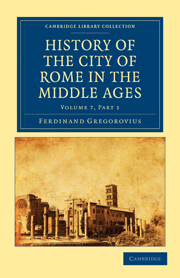CHAPTER II
Published online by Cambridge University Press: 01 March 2011
Summary
Stefano Porcaro.
Immediately after the death of Eugenius a democratic movement threatened to break out in Rome, of which the knight Stefano Porcaro hoped to become the leader. He was a man of fantastic ideas, who thirsted for fame, was filled with enthusiasm for the ideals of the past, but had no clear grasp of the present. He belonged to an ancient bourgeois family, but wishing to represent himself as descended from the Catos, he changed his name to Porcius.
His abilities had attracted the attention of Martin V., to whose recommendation he owed the office of Captain of the People in Florence. After having honourably filled the post in 1427 and 1428, he travelled through France, Germany, and other countries, and returned to Rome with his younger brother Mariano in 1431. Although an adherent of the Colonnas, Eugenius made him Podesta of Bologna in 1433, and this office he also filled with distinction. During the revolution in Rome in 1434, Porcaro had gone to Florence as mediator between the Pope and the Roman populace; he appears in the same year as Podestà in Siena, and was afterwards sent by Eugenius in the same capacity to Orvieto. Here also during the year 1436 he gained the affections of the citizens and the praise of the patriarch Vitelleschi as well as of the Pope.
Poggio, Lionardo Aretino and Traversari, Ciriaco and Manetti, Niccoli and other men belonging to learned circles in Florence and Rome respected Porcaro as a classically educated Roman of brilliant talents, which rendered him a favourite with all whom he encountered.
- Type
- Chapter
- Information
- History of the City of Rome in the Middle Ages , pp. 101 - 175Publisher: Cambridge University PressPrint publication year: 2010First published in: 1900



